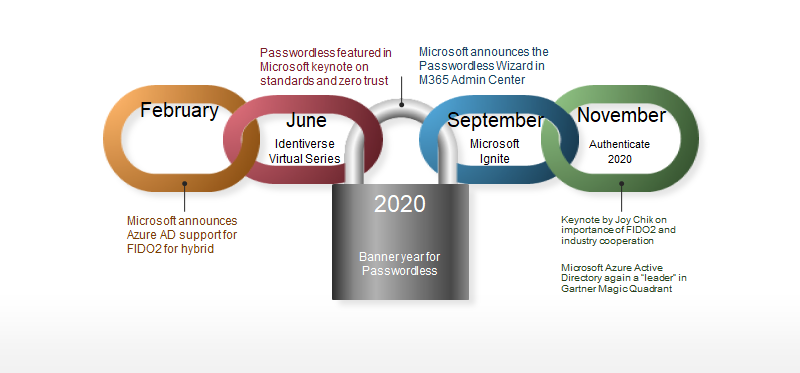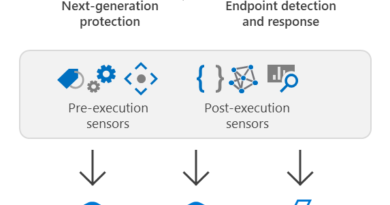A breakthrough year for passwordless technology
As 2020 draws to a close, most of us are looking forward to putting this year in the rearview mirror. Since we depend even more on getting online for everything in our lives, we’re more than ready to be done with passwords. Passwords are a hassle to use, and they present security risks for users and organizations of all sizes, with an average of one in every 250 corporate accounts compromised each month. According to the Gartner Group, 20 to 50 percent of all help desk calls are for password resets. The World Economic Forum (WEF) estimates that cybercrime costs the global economy $2.9 million every minute, with roughly 80 percent of those attacks directed at passwords.
In November 2019 at Microsoft Ignite, we shared that more than 100 million people were already using Microsoft’s passwordless sign-in each month. In May of 2020, just in time for World Password Day, that number had already grown to more than 150 million people, and the use of biometrics to access work accounts is now almost double what it was then. We’ve drawn strength from our customers’ determination this year and are set to make passwordless access a reality for all our customers in 2021.
2020: A banner year for passwordless technology

February: We announced a preview of Azure Active Directory support for FIDO2 security keys in hybrid environments. The Fast Identity Online (FIDO) Alliance is a “cross-industry consortia providing standards, certifications, and market adoption programs to replace passwords with simpler, stronger authentication.” Following the latest FIDO spec, FIDO2, we enabled users with security keys to access their Hybrid Azure Active Directory (Azure AD) Windows 10 devices with seamless sign-in, providing secure access to on-premises and cloud resources using a strong hardware-backed public and private-key credential. This expansion of Microsoft’s passwordless capabilities followed 2019’s preview of FIDO2 support for Azure Active Directory joined devices and browser sign-ins.
June: I gave a keynote speech at Identiverse Virtual 2020 where I got to talk about how Microsoft’s FIDO2 implementation highlights the importance of industry standards in implementing Zero Trust security and is crucial to enabling secure ongoing remote work across industries. Nitika Gupta, Principal Program Manager of Identity Security in our team, showed how Zero Trust is more important than ever for securing data and resources and provided actionable steps that organizations can take to start their Zero Trust journey.
September: At Microsoft Ignite, the company revealed the new passwordless wizard available through the Microsoft 365 Admin Center. Delivering a streamlined user sign-in experience in Windows 10, Windows Hello for Business replaces passwords by combining strong MFA for an enrolled device with a PIN or user biometric (fingerprint or facial recognition). This approach gives you, our customers, the ability to deliver great user experiences for your employees, customers, and partners without compromising your security posture.
November: Authenticate 2020, “the first conference dedicated to who, what, why and how of user authentication,” featured my boss, Joy Chik, CVP of Identity at Microsoft, as the keynote speaker. Joy talked about how FIDO2 is a critical part of Microsoft’s passwordless vision, and the importance of the whole industry working toward great user experiences, interoperability, and having apps everywhere support passwordless authentication. November also saw Microsoft once again recognized by Gartner as a “Leader” in identity and access management (IAM).
MISA members lead the way
The Microsoft Intelligent Security Association (MISA) is an ecosystem of security partners who have integrated their solutions with Microsoft to better defend against increasingly sophisticated cyber threats. Four MISA members—YubiKey, HID Global, Trustkey, and AuthenTrend—stood out this year for their efforts in driving passwordless technology adoption across industries.
Yubico created the passwordless YubiKey hardware to help businesses achieve the highest level of security at scale.
“We’re providing users with a convenient, simple, authentication solution for Azure Active Directory.”—Derek Hanson, VP of Solutions Architecture and Alliances, Yubico
HID Global engineered the HID Crescendo family of FIDO-enabled smart cards and USB keys to streamline access for IT and physical workspaces—enabling passwordless authentication anywhere.
“Organizations can now secure access to laptops and cloud apps with the same credentials employees use to open the door to their office.”—Julian Lovelock, VP of Global Business Segment Identity and Access Management Solutions, HID
TrustKey provides FIDO2 hardware and software solutions for enterprises who want to deploy passwordless authentication with Azure Active Directory because: “Users often find innovative ways to circumvent difficult policies,” comments Andrew Jun, VP of Product Development at TrustKey, “which inadvertently creates security holes.”
AuthenTrend applied fingerprint-authentication technology to the FIDO2 security key and aspires to replace all passwords with biometrics to help people take back ownership of their credentials.
Next steps for passwordless in 2021
Our team has been working hard this year to join these partners in making passwords a thing of the past. Along with new UX and APIs for managing FIDO2 security keys enabling customers to develop custom solutions and tools, we plan to release a converged registration portal in 2021, where all users can seamlessly manage passwordless credentials via the My Apps portal.
We’re excited about the metrics we tracked in 2020, which show a growing acceptance of passwordless among organizations and users:
- Passwordless usage in Azure Active Directory is up by more than 50 percent for Windows Hello for Business, passwordless phone sign-in with Microsoft Authenticator, and FIDO2 security keys.
- More than 150 million total passwordless users across Azure Active Directory and Microsoft consumer accounts.
- The number of consumers using Windows Hello to sign in to Windows 10 devices instead of a password grew to 84.7 percent from 69.4 percent in 2019.
We’re all hoping the coming year will bring a return to normal and that passwordless access will at least make our online lives a little easier.
Learn more about Microsoft’s passwordless story. To learn more about Microsoft Security solutions, visit our website. Bookmark the Security blog to keep up with our expert coverage on security matters. Also, follow us at @MSFTSecurity for the latest news and updates on cybersecurity.
READ MORE HERE



